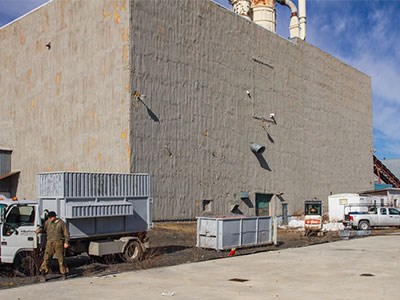Amothballed crushing mill in Matheson is being refurbished by a Toronto industrial minerals company with the aim of processing flake graphite imported from South America.
Great Lakes Graphite has struck a five-year agreement with DNI Metals to procure graphite from Brazil for shipment to the northeastern Ontario plant, where the company is refitting a micronization plant.
The company has a facilities use agreement for five years with the mill’s owner, Northfill Resources, with the option for another five, to crush flake graphite into fine powder, according to customer specifications.
The graphite would arrive by ship in Montreal and then be railed the rest of the way to Matheson, the last leg on the Ontario Northland Railway.
The mill has been shuttered for about 15 years. Once owned by Hedman Resources, a Toronto exploration and mining firm, there were aspirations to process vermiculite and other agriculture-related minerals in the early 2000s. That company was never able to source any supply and the mill was closed soon after it was commissioned.
Great Lakes Graphite is spending $800,000 to refit the facility, located 70 kilometres east of Timmins, and begin commercial production by early 2016.
Company CEO Paul Gorman said the mill will be a “lean” operation with four people working one shift, five days a week, at the outset.
Three milling units were shipped down to the original manufacturers in Orangeville for refurbishment and modifications with additional grinding hammers to achieve very fine micron grades for customers.
“There’s no wear-and-tear on the machines other than compressed bearings that have to be redone,” said Gorman, who called the facility’s condition “amazing.”
“It’s like the place was frozen in time for 15 years.”
Though geographically off the beaten track, he said, the buildings are structurally sound with almost bomb-proof footings, structural steel and concrete pad.
Local companies like Norfab and LPL Contracting were hired to move equipment, brush out the grounds and make electrical upgrades.
The customer order book is beginning to fill up, but the company prefers to remain “stealthy” on who they’re conversing with, said Gorman, noting that there’s plenty of “long-hanging fruit” to supply graphite to industrial lubricant and refractory brick companies in the U.S. Midwest.
However, there’s much bigger fish out there for the company.
Gorman calls graphite the “new black gold” as a natural carbon with many properties well suited for a variety of industrial uses, such as manufacturing batteries, steel and lubricants for the automotive and electrical sectors.
Most of the graphite used in North
America comes from
China.
Beijing imposes huge tariffs on graphite exports and there’s always the looming threat of China curtailing supply to use for their own needs.
Graphite has become a critical component in making lithium-ion batteries used in electric cars.
Gorman is particularly eyeballing Tesla Motors’ plans to build a $5-billion lithium-ion battery “Gigafactory” next year in the U.S.
It could skyrocket the demand for graphite, and Gorman wants his company to be among the first North American suppliers to cater to high-tech companies.
With Matheson, they can source quality flake from anywhere in the world and micronize it down anywhere from 45 to 5 microns, or according to customer specifications.
To further build their case, the company acquired a graphite property – the Lochaber Project – near Buckingham, Que.
They’ve presented samples to electric car companies and battery makers to potentially sign on as customers down the road.
“We want to show off to them that we’re not actually talking about it, we’re actually doing it,” said Gorman.
The plan is to finance Lochaber as a quarry-style operation through revenues generated from Matheson.
In the future, some of that feedstock could be sent to Matheson.
Gorman said the company has some promising Ontario industrial mineral properties, but their near-term focus remains getting Matheson operational.
The mill has a production capacity of 100,000 tonnes annually, yet the company’s needs are relatively modest in reaching 1,500 tonnes for the first month, ramping up to between 3,500 to 5,000 tonnes in year two, and 10,000 tonnes by the third year.
Gorman believes it could serve as a toll milling operation to micronize talc, vermiculite and other food grade material from other industrial mineral companies.
“We could probably have three or four opportunities in there and we’re talking to different groups about that.”




